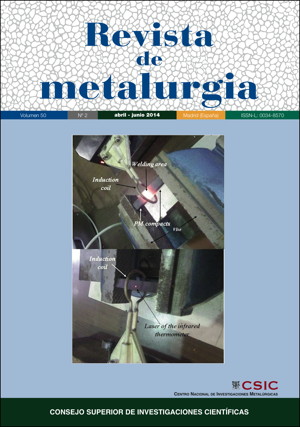Microwave-assisted grinding of metallurgical coke
DOI:
https://doi.org/10.3989/revmetalm.013Keywords:
Coke, Energy saving, Grindability, Microwave, Thermal shockAbstract
Metallurgical cokes are composed of graphitic carbon (s2p2) and different inorganic compounds with very different capacities to absorb microwave radiation. Moreover, due to the electric conductivity shown by the metallurgical cokes, microwave radiation produces electric arcs or microplasmas, which gives rise to hot spots. Therefore, when these cokes are irradiated with microwaves some parts of the particle experiment a rapid heating, while some others do not heat at all. As a result of the different expansion and stress caused by thermal the shock, small cracks and micro-fissures are produced in the particle. The weakening of the coke particles, and therefore an improvement of its grindability, is produced. This paper studies the microwave-assisted grinding of metallurgical coke and evaluates the grinding improvement and energy saving.
Downloads
References
Babich, A., Yaroshevskii, S., Garc.a, L., Formoso, A., Cores, A., Isidro, A., Ferreira, S. (1996). Technological improvements in the pulverized coal injection process in the blast furnace. Rev. Metal. 32 (2), 103–116. http://dx.doi.org/10.3989/revmetalm.1996.v32.i2.921
Chenje, T.W., Simbi, D.J., Navara, E. (2003). Wear performance and cost effectiveness - A criterion for the selection of grinding media for wet milling in mineral processing operations. Miner. Eng. 16 (12), 1387–1390. http://dx.doi.org/10.1016/j.mineng.2003.08.009
Chenje, T.W., Simbi, D.J., Navara, E. (2004). Relationship between microstructure, hardness, impact toughness and wear performance of selected grinding media for mineral ore milling operations. Mater. Des. 25 (1), 11–18. http://dx.doi.org/10.1016/S0261-3069(03)00168-7
Church, R.H., Webb, W.E., Salsman, J.B. (1988). Dielectric properties of low-loss minerals. U. S. Bureau of Mines. Report of Investigations. Report 9194.
Didenko, A.N., Zverev, B.V., Prokopenko, A.V. (2005). Microwave fracturing and grinding of solid rocks by example of kimberlite. Doklady Physics 50 (7), 349–350. http://dx.doi.org/10.1134/1.2005358
Fitzgibbon, K.E., Veasey, T.J. (1990). Thermally assisted liberation - a review. Miner. Eng. 3 (1–2), 181–185. http://dx.doi.org/10.1016/0892-6875(90)90090-X
Güng.r, A., Atalay, .. (1998). Microwave processing and grindability. Innovations in Mineral and Coal Processing. Innovations in Mineral and Coal Processing: Proceedings of the 7th International Mineral Processing Symposium, Istanbul, 13–16.
Hearson, H.R. (1922). The Manufacture of Iron and Steel; E & F. N. Spon Ltd., London, UK.
Holman, B.W. (1926). Heat treatment as an agent in rock breaking. Trans. Inst. Min. Metall. 36, 219–234.
Kingman, S.W., Rowson, N.A. (1998). Microwave treatment of minerals - a review. Miner. Eng. 11 (11), 1081–1087. http://dx.doi.org/10.1016/S0892-6875(98)00094-6
Kingman, S.W., Vorster, W., Rowson, N.A. (2000). The influence of mineralogy on microwave assisted grinding. Miner. Eng. 13 (3), 313–327. http://dx.doi.org/10.1016/S0892-6875(00)00010-8
Kingman, S.W., Jackson, K., Cumbane, A., Bradshaw, S.M., Rowson, N.A., Greenwood, R. (2004). Recent developments in microwave assisted comminution. Int. J. Miner. Process. 74 (1–4), 71–83. http://dx.doi.org/10.1016/j.minpro.2003.09.006
Krestou, A., Panias, D. (2004). 1st International Conference on Advances in Mineral Resources Management and Environmental Geotechnology Hania, Greece, 215–220.
Lester, E., Kingman, S. (2004). The effect of microwave preheating on five different coals. Fuel 83 (14–15), 1941–1947. http://dx.doi.org/10.1016/j.fuel.2004.05.006
Lester, E., Kingman, S., Dodds, C. (2005). Increased coal grindability as a result of microwave pretreatment at economic energy inputs. Fuel 84 (4), 423–427. http://dx.doi.org/10.1016/j.fuel.2004.09.019
Lester, E., Kingman, S., Dodds, C., Patrick, J. (2006). The potential for rapid coke making using microwave energy. Fuel 85 (14–15), 2057–2063. http://dx.doi.org/10.1016/j.fuel.2006.04.012
Marland, S., Han, B., Merchant, A., Rowson, N. (2000). The effect of microwave radiation on coal grindability. Fuel 79 (11), 1283–1288. http://dx.doi.org/10.1016/S0016-2361(99)00285-9
Menéndez, J.A., Arenillas, A., Fidalgo, B., Fern.ndez, Y., Zubizarreta, L., Calvo, E.G., Berm.dez, J.M. (2010). Microwave heating processes involving carbon materials. Fuel Process. Technol. 91 (1), 1–8. http://dx.doi.org/10.1016/j.fuproc.2009.08.021
Mular, A.L., Bhappu, R.B. (1982). Dise-o de plantas de proceso de minerales, Madrid.
Schubert, U.S., Hoogenboom, R., Wilms, T.F.A., Erdmenger, T. (2009). Microwave-assisted chemistry: a closer look at heating efficiency. Aust. J. Chem. 62 (3), 236–243. http://dx.doi.org/10.1071/CH08503
Stoltze, S. (2000). The use of pet coke in cement manufacturing plants: Presentation of industrial cases of grinding and firing of pet coke. 11th International Cement Conference Hammamet, Tunisie, 9.
Wills, B.A., Napier-Munn, T. (2006). Wills mineral processing technology: an introduction to the practical aspects of ore treatment and mineral recovery. Butterworth-Heinemann, 2006.
Published
How to Cite
Issue
Section
License
Copyright (c) 2014 Consejo Superior de Investigaciones Científicas (CSIC)

This work is licensed under a Creative Commons Attribution 4.0 International License.
© CSIC. Manuscripts published in both the printed and online versions of this Journal are the property of Consejo Superior de Investigaciones Científicas, and quoting this source is a requirement for any partial or full reproduction.
All contents of this electronic edition, except where otherwise noted, are distributed under a “Creative Commons Attribution 4.0 International” (CC BY 4.0) License. You may read the basic information and the legal text of the license. The indication of the CC BY 4.0 License must be expressly stated in this way when necessary.
Self-archiving in repositories, personal webpages or similar, of any version other than the published by the Editor, is not allowed.
















